A grimace revealing powerful yellow incisors clearly indicated we were too close. As our game drive vehicle gently reversed, the female leopard, Thandi, relaxed and settled back in the thicket with her seven-month-old cub, panting as she digested her latest kill. An impala carcass hung limply in the branches nearby.
Leopards are famously elusive – but here in the private Sabi Sands Game Reserve, on the edge of Kruger National Park in South Africa, these cats are so habituated to human presence, they’re commonly seen strolling nonchalantly past vehicles of tourists, unconcerned by the frantic clicking of cameras.
Though their presence in the Sabi Sands might suggest otherwise, South Africa’s leopard population faces an uncertain future. In a country where reserves and national parks are surrounded by farms, roads and developments, leopards have been forced into ever smaller areas. In some populations, as one recent paper shows, this has led to inbreeding – something that can have long-lasting, catastrophic effects, impacting the cats’ resistance to illnesses and climate events like droughts, and even resulting in local extinction.
“You're looking at anything between 70 to 100 years to recover any kind of diversity,” says the paper’s lead author, Vincent Naude, a PhD candidate at the University of Cape Town.
In the face of global development, how can conservationists protect species like leopards that require room to roam, but are increasingly meeting barriers, from busy roads to conflicts with farmers?
You might also like:
- The coast overwhelmed with otters
- The folklore saving animals’ lives
- The albatrosses who hunt fish pirates
In their recent study, Naude and his colleagues propose wildlife corridors linking reserves to other protected areas as one possible solution to encourage gene flow. Wildlife corridors – tracts of land through which animals can safely disperse or migrate – might come in the form of pockets of undeveloped land or underpasses that allow animals to cross busy roads, but in essence they connect what would otherwise be separated populations.
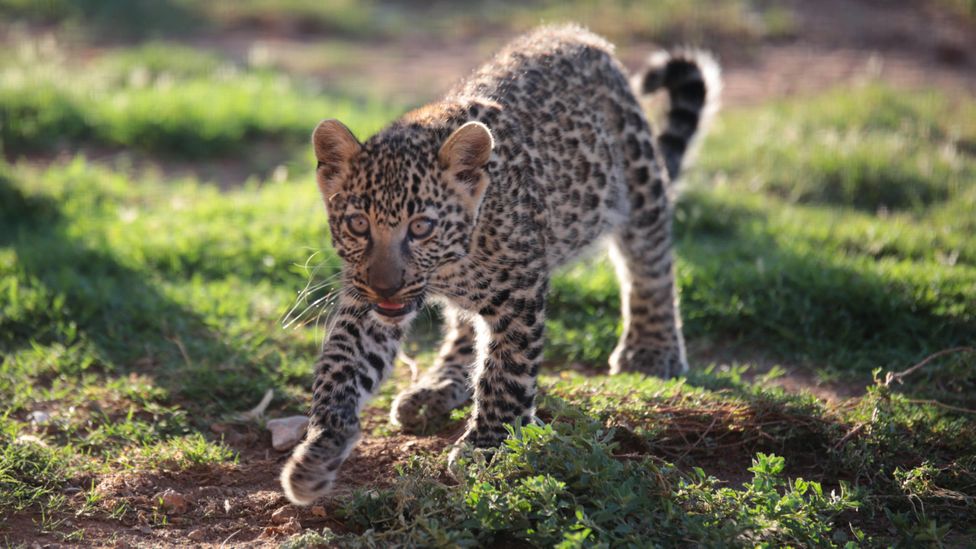
Leopards can range hundreds of miles from their birthplace through their lives, which helps them to avoid inbreeding (Credit: Getty Images)
Naude’s study demonstrates what happens when these essential connections are lacking.
The researchers studied two populations of leopards in South Africa – one in the Sabi Sands and one in the Phinda-Mkhuze Complex, in the eastern province of KwaZulu-Natal. The latter’s leopard population is currently recovering from years of over-exploitation (for example, from poaching or retaliatory conflict), where half of leopard deaths were human-related. Though they’re now making a demographic recovery, “the entire population is a little bit more related than you'd expect at random”, says Naude.
There are several possible reasons for this. Firstly, the lack of land for animals to safely traverse without coming into conflict with humans. Male leopards can disperse as far as 200 miles (322km) away from where they were born, known as their natal range. This movement reduces inbreeding, as there’s no evidence to show leopards have kin-recognition, says Naude.
Secondly, threats such as hunting for skins or traditional medicine, or poorly managed trophy hunting, have historically targeted the larger males – the ones that would typically push young males out of an area. Without that competition, young males stick around their natal range, ultimately breeding with their relatives.
Genetic diversity improves overall health and resilience, helping species survive events such as extreme droughts or disease outbreaks. If a population becomes too small, they go into what is known as a “depressant spiral”, Naude explains, which is the start of genetic deterioration in the population. “It’s not necessarily even going to be a weird tail or a reduced sperm count. [The population] tends to collapse in on itself.” Because leopards already occur at such low density, doesn’t take much to tip them from a depressant spiral to the start of the process of extinction, known as an “extinction vortex”.
Other predators in South Africa – lions, wild dogs, cheetahs – are managed by conservationists, moved around reserves and often to other countries to help with repopulation or genetic diversity. But leopards are a unique challenge: unlike other apex predators in South Africa, 62% of their known range is outside protected areas.
Cape leopards in South Africa’s Western and Eastern Cape provinces are perhaps the hardest to protect. “They have half the body mass size of a savannah leopard, but have territories 10 times larger,” says Helen Turnbull, chief executive of the Cape Leopard Trust. There’s no data to suggest Cape leopards are a subspecies – it’s likely they’ve just adapted to a diet of smaller, sparser prey. “A male [Cape] leopard can have a territory of 1,000km (621 miles), whereas a savannah leopard will be 10km (6.2 miles),” Turnbull says.
The regions in South Africa where Naude has been working are currently lacking in wildlife corridors for solitary big cats. But an answer might come from India, where researchers have provided plenty of evidence of how and why they work.
Indian corridors
Trishna Dutta, a scientist at the University of Goettingen in Germany, studied wildlife corridors between four protected areas in central India, focusing on tigers, leopards and sloth bears. The aim, when fieldwork commenced in 2008, was simply to assess how functional these corridors were. Given that the landscape is so “fragmented”, says Dutta, with many roads and villages, she and her colleagues had not expected to find many animals moving along the corridors and – crucially – reproducing on the other side to widen the gene pool.
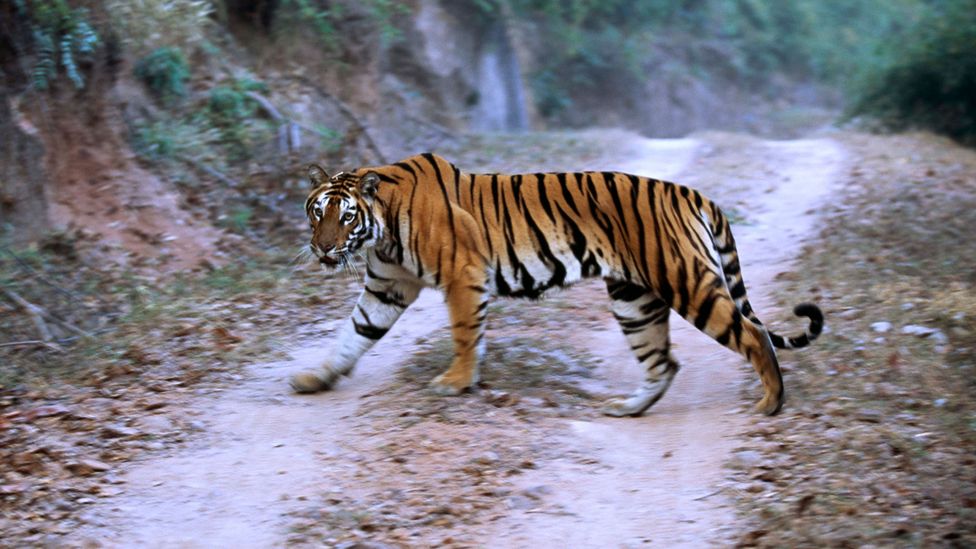
In India, joining up fragmented habitats has benefitted tigers and leopards alike (Credit: Getty Images)
“What we found, in a sentence, was that these corridors actually proved to be functional for all three species,” Dutta says. “Instead of four genetic populations, we found two. And these two were the ones that were connected by the corridors.”
The corridors in central India are not pristine wilderness – they are formerly forested areas that have gradually been converted for human use; the land Dutta studied is “what is left”. One of Dutta’s positive findings was that even a fragmented corridor can be very effective.
“People think of a corridor as like a linear stretch of land that connects to circles in a perfect textbook picture – [but] that's really not what it needs, at least in my experience with central India and this landscape,” Dutta explains. “There is something called stepping-stone corridors… basically little islands, patches of forest.” For animals as adaptable as leopards – which live on the savannah, in mountains, even in cities – this can be enough.
Naude agrees that a corridor doesn’t need to be much: “Frankly you just need to create a reasonably safe space where there's enough prey for them [leopards] to move through,” he says. “A corridor, even if it's a shoddy one, would probably go a long way to helping a species that's so adaptable.”
Wildlife infrastructure
Besides leaving some stretches of undeveloped land between reserves or areas of wilderness, what other approaches are there to provide wildlife corridors?
One method is to take the big-picture approach, such as the Mesoamerican Biological Corridor, which aimed to connect a series of protected corridors from southern Mexico to Panama, an idea conceived around 1990 and formally endorsed in 1997. But recently its effectiveness has been called into question, largely due to poor communication and fragmented protected areas.
The other method is to take the local approach: In many cases, an underpass or bridge is all it takes to reconnect the ecosystem. The four-lane Trans-Canada Highway in Banff National Park, for example, is a hazard for animals such as black bears, deer, elk, moose, wolves and cougars (or mountain lions). Since 1983, the park has built a series of 48 wildlife crossings – seven bridges and 41 underpasses – as part of the longest ongoing wildlife crossing research and monitoring programme in the world. They have more crossings and highway fencing than any other location, which has reduced wildlife-vehicle collisions by up to 80% for all species – also reducing human fatalities by around 80%.
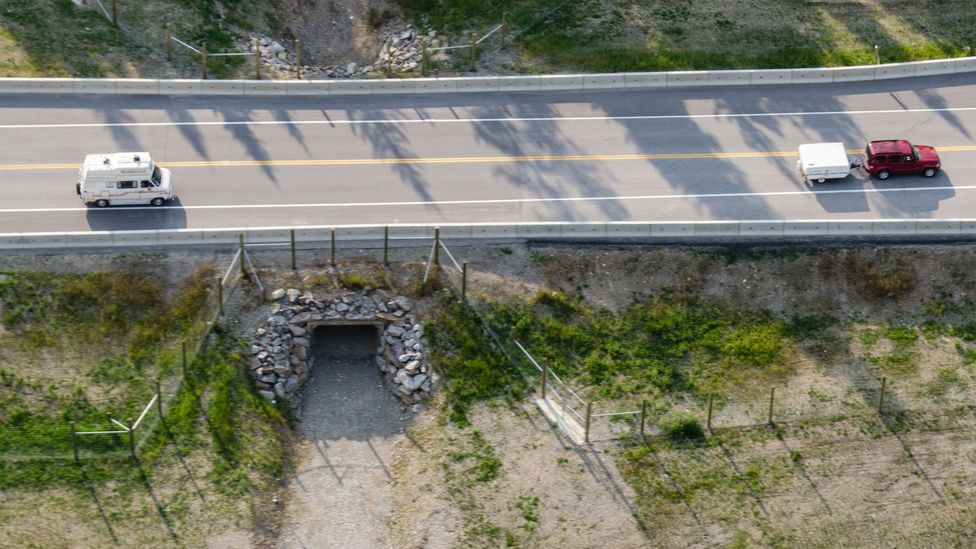
Underpasses, such as this one in Canada, can be enough to provide safe passage for a number of large animals (Credit: Parks Canada)
Some of that valuable experience is now being shared with biologists and engineers working on what will almost certainly be the largest wildlife crossing in the world.
The Liberty Canyon wildlife crossing will bridge the 101 freeway in Los Angeles, crossing 10 lanes and an access road. It’s a huge, challenging project: there’s only one viable spot to build it, and it won’t be a straight shot across; light and sound mitigation (around 300,000 cars will pass under the bridge every day) need to be factored in. And, as small animals – birds, butterflies, lizards – will likely live on the structure, consideration needs to go into the covering; if it’s covered in vegetation, for example, there needs to be a safety net of some kind to stop anything dropping to the road. The current cost estimate is $87m (£66m); it’s a public-private partnership with 80% being covered by private donors, such as the Leonardo DiCaprio Foundation. They’re due to break ground next year and aim to finish by the end of 2023.
Though it will benefit many other species, the main aim of the bridge is to reconnect LA’s mountain lions to the Santa Monica Mountains.
“We have almost 20 years of data on how the cats move in this landscape,” says Beth Pratt, California’s regional executive director for the National Wildlife Federation. Talking to me via Zoom from her home outside Yosemite, Pratt sports an ‘I heart P-22’ t-shirt – P-22 is the famous Hollywood cougar, the mascot of this project.
The freeway has trapped mountain lions like P-22 in just eight square miles (21 sq km) – and the territory for a male cougar is typically around 150-200 square miles (390-520 sq km). “Animals are not hit as much there [on the 101] because they turn around – they don't even try,” says Pratt.
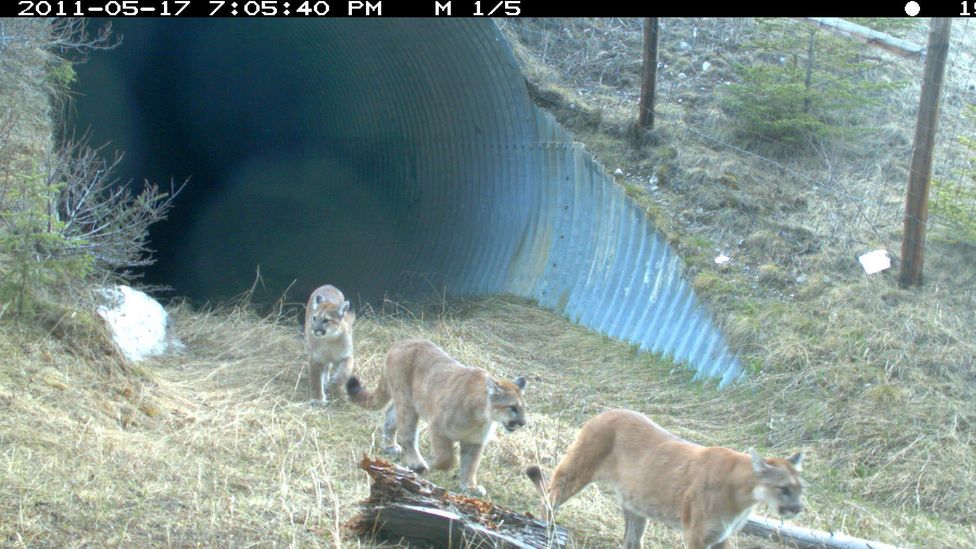
Introducing wildlife-friendly infrastructure helps reduce inbreeding, and can be more effective than portioning off areas of land for nature reserves (Credit: Parks Canada)
“The genetic modelling that the National Park Service has done has shown that, at best, we have 50 years before these guys go extinct, because they just will not become viable to breed anymore,” Pratt explains, adding that other risks – such as vehicle collisions – can easily accelerate that timeline in a population of around 10 to 15. Although the focus is the mountain lion – which makes a charismatic poster species for fundraising – Pratt says research has also revealed genetic isolation in other species in the area, too. “We now know [if] we split habitat… that ecosystem is going to die, or at least substantially change.”
Breaking down the fortress
This is part of a shift away from “fortress conservation” thinking, meaning national parks and private reserves – from which people have often been forcibly removed – cannot be long-term solutions for protecting ecosystems. Instead, a rights-based, multi-use approach to land is seen as the ethical option, with far more longevity. Key to this is being able to work with people, whether you’re building a multi-million dollar wildlife crossing in LA or helping farmers mitigate leopard attacks on livestock in South Africa.
“I would start with working with people first,” says Dutta, when asked about creating corridors. She notes that in India, it’s easier to work with existing corridors because people are already used to living with tigers and leopards. But trying to create an entirely new one could be problematic. “Let's say you create a forest,” says Dutta. “And then animals start moving in. I mean, this community really doesn't know how to exist with them anymore.”
In South Africa, which has historically followed a fortress conservation model, wildlife corridors and crossings may be the only way to protect species such as leopards. But the transition away from nature fortresses will not be easy – for two main reasons.
The first is that land is a deeply political issue in South Africa, one of the most unequal countries in the world. Over 70% of land is owned by white people, who make up less than 9% of the population; land restitution and redistribution have been promised since the end of formal apartheid in 1994. If swathes of land were to be dedicated to wildlife corridors, there would likely be understandable outrage.
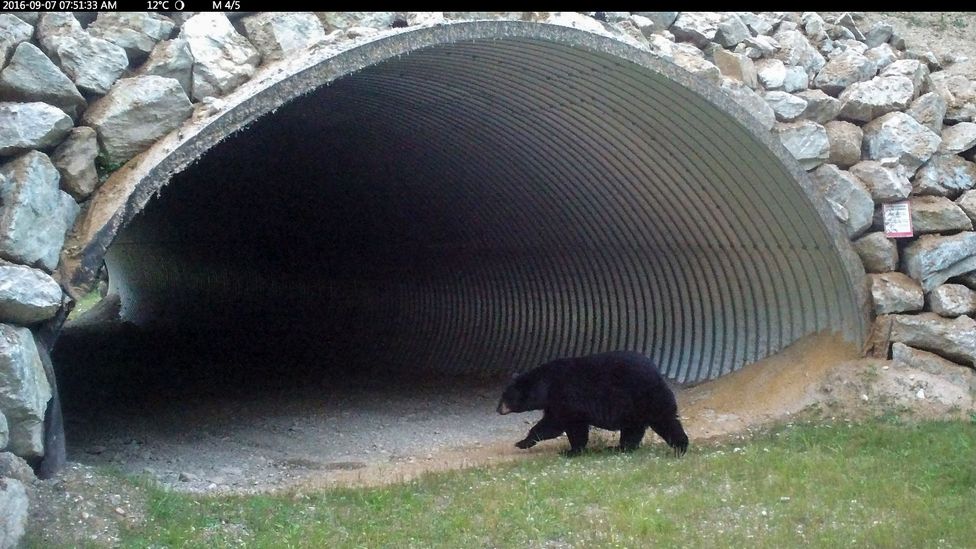
Many large mammals benefit from wildlife tunnels, which are increasingly being seen as a sustainable alternative to walling off animals in nature researves (Credit: Parks Canada)
The second is that corridors require communities and farmers to be fully on board with potentially dangerous animals moving through or close to their land. Naude suggests subsidising people for any lost livestock, as well as the sharing of information and conflict mitigation strategies. These initiatives, along with boma (livestock enclosures) fortification, are already practised in many parts of sub-Saharan Africa.
Nevertheless, there are plans afoot for protected corridors in South Africa. The Cape Leopard Trust, for example, is investigating the integrity of potential corridors in the Western Cape, including one on the Agulhas coast in partnership with the Endangered Wildlife Trust. As well as acting as safe areas for Cape leopards to traverse, such corridors can protect fynbos vegetation, orchids and amphibians such as the endangered Cape platanna frog. Conservation work by local landowners has laid some groundwork – the Nuwejaars Wetlands Special Management Area, for example, where 25 landowners have agreed to protect over 46,000 hectares (113,668 acres), signing title deeds that commit their land to conservation forever.
There’s a long way to go, but the steady growth of wildlife corridors can help stitch disjointed ecosystems back together before it’s too late for animals like leopards. After all, encroaching on nature has unintended consequences for animals and human civilisation alike. “A lot of people are recognising that now,” says Pratt. “If ecosystems aren’t made whole, human health is going to suffer as well.”
--
The emissions from travel it took to report this story were 0kg CO2. The digital emissions from this story are an estimated 1.2g to 3.6g CO2 per page view. Find out more about how we calculated this figure here.
--
Join one million Future fans by liking us on Facebook, or follow us on Twitter or Instagram.
If you liked this story, sign up for the weekly bbc.com features newsletter, called “The Essential List”. A handpicked selection of stories from BBC Future, Culture, Worklife, and Travel, delivered to your inbox every Friday.
"save" - Google News
August 27, 2020 at 06:23AM
https://ift.tt/3b0zhgL
The bold plan that could save South Africa's leopards - BBC News
"save" - Google News
https://ift.tt/2SvBSrf
https://ift.tt/2zJxCxA
Bagikan Berita Ini














0 Response to "The bold plan that could save South Africa's leopards - BBC News"
Post a Comment